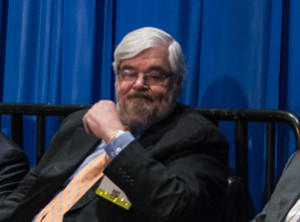Pete Miller: Offshore drilling must become economical at $30 oil
By Alex Endress, Editorial Coordinator

As the downturn continues with no end in sight, it’s clear that offshore drilling contractors must learn to operate long term at lower oil prices. “We have to be able to drill in this industry in the $30s,” Pete Miller, Chairman of the Board of Directors for Transocean, said during a panel discussion at the 2016 OTC in Houston on 4 May. Achieving profitability at this level will be possible, he said, by focusing on strategic geographic position, technological innovation and flexibility in contract models.
Mr Miller urged drilling contractors to position themselves in areas of the world where energy demand is growing. “Don’t just look at the major economies around the world. Take a look at where the growth is coming from.” He pointed to Mexico, Indonesia, Nigeria and Turkey as countries where energy demand is expected to grow significantly. “We hope that we’re going to have rigs positioned such that we can actually help satisfy some of the demand growth with some of the hydrocarbons that we’re finding in these particular areas.” While operating in these regions, drilling contractors must also be well positioned to provide a consistently reliable level of service in all parts of the world, he said.
In particular, Mr Miller cited automation technologies as an area of potential cost savings offshore, noting that companies need to seek out innovations that can reduce drilling time. The offshore industry may even look to the onshore market and learn from how that segment of the market has rapidly pushed technological and performance improvements over the past decades. “We can take the learnings of shale to become more efficient offshore.” He referenced his own experience drilling onshore in Red Fork, Okla., in the 1980s, when a 13,000-ft shale well might have taken 90 days and 13 drill bits to finish. Today, he said the same operation can be done in only six days with two bits. Offshore, he sees automated technologies that are able to track and compare performance data from across a company’s fleet as an area that can help companies and crews learn to operate more effectively. “There’s so many learnings from that, just in how the crews work,” he said. “We want to see that – what we can do to become more efficient.”
Keeping contracts and service costs reasonable may also mean companies need to seek out different contract models, he said. One example is contracts that begin with lower dayrates but allow drilling contractors to share in the cost savings that operators receive from reserves found. The contract also would spread the costs of downtime among both operators and drilling contractors. “Part of what (drilling contractors) do is going to have to be putting some risk on the table, and we ought to be able to gain from that,” he said. “We put some skin in the game, but (operators) then pay us a portion of what they might be saving.”




